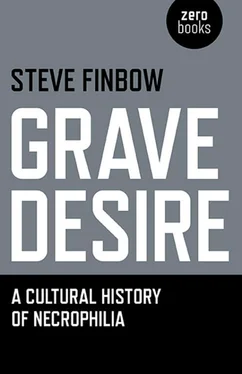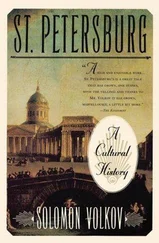In researching this book I have come to the conclusion that pseudonecrophilia is the domain of fantasists and occultists, people interested in morbid pornography, gothic art, horror films and novels. So-called regular necrophiles are rare and the majority of them are drawn to the act through proximity, availability and curiosity; very few practice necrophilia exclusively, most are unable to establish sexual relationships with other people of either sex and practice necrophilia along with other paraphilias such as bestiality and sadomasochism. The alleged necrophilia of ex-BBC disc jockey Jimmy Savile (if found to be true) constitutes a fragment of his wider biastophilia or raptophilia, and his desire to rape women, underage children (of both sexes), brain-damaged patients and dying residents of hospitals and hospices. In Irvine Welsh’s “Lorraine Goes to Livingston,” in Ecstasy, the character of Freddy Royle, a thinly disguised portrait of Savile, uses his power and contacts to satisfy his lusts.
‘Yes, the trustees knew all about Freddy Royle, Glen reflected bitterly. They knew the real secrets of the chat-show host, the authors of several books, including Howzat! – Freddy Royle On Cricket, Freddy Royle’s Somerset, Somerset With a Z: The Wit of the West Country, West Country Walks With Freddy Royle and Freddy Royle’s 101 Magic Party Tricks. Yes, those trustee bastards knew what this distinguished friend, this favorite caring, laconic uncle to the nation did with the stiffs they got in here. The thing was, Freddy brought millions of pounds into the place with his fund-raising activities. This brought kudos to the trustees, and made St Hubbin’s Hospital a flagship for the arm’s-length trusts from the NHS. All they had to do was keep schtumm and indulge Sir Freddy with the odd body.’ [289] Ecstasy: Three Tales of Chemical Romance, p. 9.
In England’s Darkness, Stephen Barber allies Savile with Peter Sutcliffe, imagining a meeting between the two men.
‘He evoked—deliriously, in bursts, as though speaking in glossolalia—a meeting that had taken place, in October 1988, at the Broadmoor hospital for the criminally insane, between the two now-dead but still-legendary ‘Kings of Leeds’, Peter Sutcliffe and Jimmy Savile, during Savile’s era as that hospital’s de-facto director, having seized power from his ostensible advisory role, at a seminal moment when, due to malfunctions of its administrative regime, the insane had ruled that asylum, sweeping-aside its directors. The two Kings of Leeds had met for profound discussions of the future, in a palatial, thickly-curtained annex of the asylum, first embracing one another warmly, then stood together, Sutcliffe’s head turned attentively to Savile, two eager interpreters beside them, as though only irreconcilable idioms of madness could be voiced. But they remained silent, as though in anticipation of being photographed, like two dictators, though no image was to be made of that meeting, and its memory subsisted solely in the pixellated hallucinations of a soon-to-be-culled rebel boy, standing in front of the pornography cinema’s screen, in the semen-preserved grandeur of the Assembly Rooms, his delirium now drained, but his throat still convulsing with the effort to expectorate, at last, a myth, an origin.’ [290] Stephen Barber, England’s Darkness, (London 2013), pp. 9-10.
Savile may have committed necrophiliac acts; in 1990 in Q Magazine, he told the interviewer about his obsession with dead bodies, while at Stoke Mandeville Hospital, he had volunteered to take dead bodies to the morgue. He may have been, like Karen Greenlee, an opportunistic necrophile (as he had been an opportunistic rapist). Yet he may also have been a fantasist and the rumours surrounding his crimes (see the Welsh extract) projections of his paedophilia in order to metamorphose him into the ultimate contemporary sexual monster. His inclusion in Barber’s apocalyptic novel and his (imagined) meeting with Peter Sutcliffe promotes/demotes Savile to the status of postmodern demon, sexual predator of hospitals, television studios, prisons and asylums—JG Ballard died three years before the Savile scandal broke but Savile retrospectively haunts the Ballardian landscape.
Of the homicidal-necrophiles such as Peter Kürten, Ed Gein, Ted Bundy and Jeffrey Dahmer, necrophilia became part of their polymorphous perversity, their manifold sexualities, their heterogeneous libidos. For the majority of us, ‘Bound in with the selfhood of the physical body, most of us believe, there lives a moral, mental, spiritual and emotional being. That is one reason why it feels so odd to me to gaze upon a corpse.’ [291] Rising Up and Rising Down, p. 150.
For serial killers like Bundy and Dahmer, necrophilia was a sexual component of their perversions and not the reason they killed women and men. The necrophile who exhumes dead bodies in order to have sex with them is a near-mythical thing, even Sergeant Bertrand mostly masturbated over the entrails. Similar to the proliferation of specialist magazine, websites and television channels, it is a matter of media targeting,
‘“Targeting,” said the male columnist, who was about twenty-eight and experimentally bearded, with a school-dinner look about him. The column the male columnist wrote was sociopolitical. “Come on, this isn’t America. Where the magazine market is completely balkanized. Where, you know, they have magazines,” he said, already looking round the table to garner any smiles that might soon be cropping up, “for the twice-divorced South Moluccan scuba diver.”’ [292] Martin Amis, The Information, (London, 1995), p. 28.
And necrophilia finds its own abhorrent balkanized place in the myriad of paraphilias—from abasiophilia, a sexual attraction to people with impaired mobility, to zoosadism, sexual excitement from watching animals in pain or causing them pain. (Some people would argue that the last paraphilia is a more malignant perversion than necrophilia, as is the torture of humans.) Like the majority of paraphilias, necrophilia is rare and targeted by the press because it is shocking, involves death and sex and excites our morbid curiosity but Sergeant Bertrand is unlikely to have a prime-time television show produced based on his exploits as the werewolf-vampire-demon-based shows Buffy the Vampire Slayer, Angel, True Blood and Being Human.
If, as Freudians contest, all love objects are substitute mother figures, then the homicidal-necrophile perpetually kills his mother to have sex with her in order to be reborn as an ‘other’ who would not then become a necrophile. If that is the case, we are all necrophiles to a certain extent because ‘[i]n the span of its lifetime, the body is also a dead body, the body of a dead person, this dead person I am when alive. Dead or alive, neither dead nor alive, I am the opening, the tomb or the mouth, the one inside the other.’ [293] Corpus, p. 15.
Aggrawal, Anil. Necrophilia: Forensic and Medico-Legal Aspects (Boca Raton, 2011)
Amis, Martin. The Information, (London, 1995)
Arendt, Hannah. Eichmann in Jerusalem (New York, 1963)
Arendt, Hannah. The Life of the Mind (Orlando, 1978)
Aristotle, The Nicomachean Ethics, (Oxford, 2009)
Bachelard, Gaston. The Poetics of Space, trans. Maria Jolas (Boston, 1994)
Ballard, J.G. Crash, (London, 2008)
Ballard, J.G. The Atrocity Exhibition (Revised edition: London, 2006)
Barber, Stephen. England’s Darkness, (London 2013)
Bataille, Georges. Bataille On Nietzsche (London, 2004)
Bataille, George. Erotism: Death & Sensuality, trans. Mary Dalwood (San Francisco, 1986)
Читать дальше












